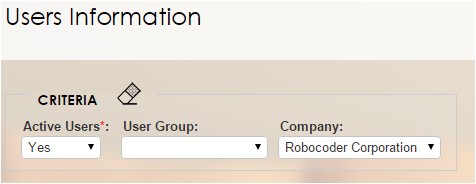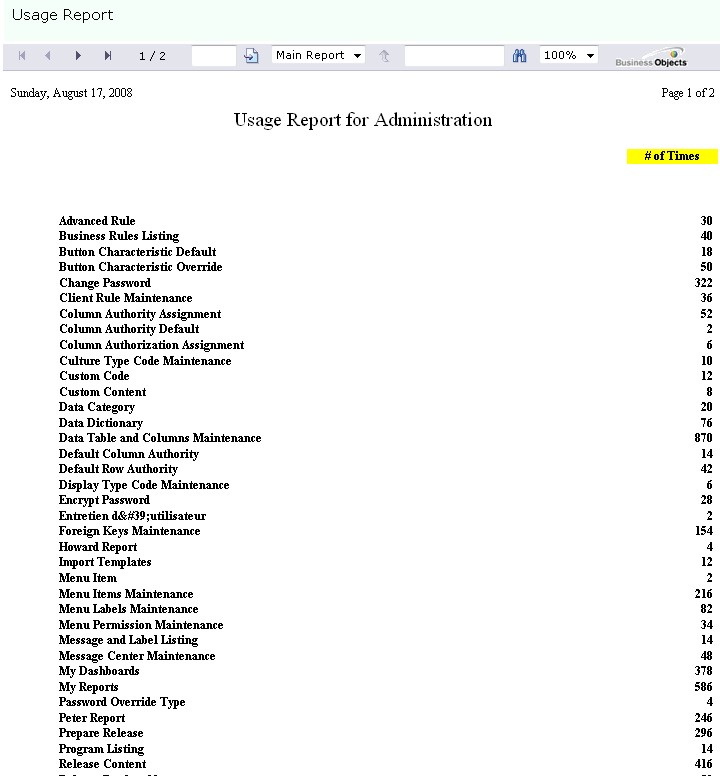Getting started
Chapter 1
This and subsequent user-guides are intended to provide usage and technical details to a wide range of audiences. Because Rintagi is intended to bring business users and professional developers together to quickly deliver enterprise grade applications, some information here may be too technical or too business oriented. If you are a business manager and you find some details overwhelming, you may ignore those and focus on the major functionality of Rintagi. On the contrary, some professional developers may need more details and they should contact Robocoder Corporation for more information.
To successfully compete in this global economy, every business tries to be unique to differentiate their products and services. Yet the service provided is often hindered by me-too technologies. Custom software is often cited as expansive and time consuming to build and many are either not built to last or failed to deliver.
The solution is Robocoder Corporation’s future-proof code generator platform – Rintagi, which stands for Rejuvenation with Integrity and Agility. It embraces late changes without penalty and many changes can be done on-the-fly. Robocoder has embedded in Rintagi all its knowledge and experience in delivering custom business process management (BPM) software applications to enterprises so that it can generate the desired application with performance and standards using agile methodology. The code produced is consistent and can replicate the same look and feel throughout the application’s user interface automatically. Complex and interactive web pages can be created with database-connected components including forms, reports, filters, and navigation features. Rintagi in the cloud is designed to be self-served so that custom BPM enterprise applications with complex functionalities can be built in hours or days, instead of months or years.
Decreased time-to-market, ease of modification, and low maintenance are inherent benefits. Standardization, process controls and continuity are easily achieved using Rintagi. Security and superior enterprise architecture are inherited when generating desired applications. Bridging the gap between business and technical personnel may be its greatest advantage. Using intuitive interfaces business people may complete a significant portion of the applications design as a blueprint for Rintagi to generate enterprise-ready code. Screen development, business rules description can be done by business people while technical professionals focus on data modeling, business rules implementation and systems integrations to create seamless and structured cloud-based or on-premises applications.
Rintagi’s ability to self-generate allows customization for itself and the applications it creates. Your corporate standards and requirements are met easily and efficiently. This customizable code generator has successfully developed (and is currently maintaining) mission-critical enterprise applications for many reputable organizations in the financial and other sectors.
Rintagi uniquely generates itself to keep pace with users’ needs and technological advancement. In fact, Rintagi has ‘grown organically’ and incrementally so that it can adapt easily to any changing environment. Upgrading Rintagi allows it to regenerate all its applications to latest interfaces and technology, and to certain extent, new architecture or languages. In theory, your generated software applications should never be obsolete again.
Rintagi rapidly generates industry standard source code (including HTML5, CSS3, JavaScript, C#, SQL Stored Procedures and Functions) that:
1. Uses existing or brand new application-specific data models.
2. Delivers bug-free source code; everything required for enterprise-ready
functional applications that link seamlessly.
3. Provides a complete and well-organized source code platform that is
easy to modify.
4. Promotes application regenerations by enabling modifications and
customizations.
5. Allows Rintagi to be enhanced as easily as the applications it generates.
Database Applications Customization
Code generation is ideal for any organization looking for consistencies in business process management (BPM) applications. For organizations adopting standard and easy to use user interactions, Rintagi can deliver quality high performance database applications fast and inexpensively with low maintenance. Although additional steps must be taken to provide unique features, Rintagi can be ‘taught’ to generate custom modifications, granting users high-control over their systems. If a new feature is required on an application the following steps can be followed:
1. Hand code the new features on the generated application and perform all tests
to verify that it meets requirements.
2. Generalize the design of this new feature so that simple meta-data information
can be captured to reproduce the same feature onto all other applications.
3. Hand code the generalized new feature into Rintagi’s generator and the user
interface to capture the required meta-data, generate this feature to replace
the hand code in step 1, make sure codes generated are exactly the same;
only then perform unit and integration testing again.
4. Where applicable, use Rintagi to generate the new feature to Rintagi itself
and perform unit and integration testing again.
Although Rintagi can be modified as easily as the applications it generates, you can see from the above that steps 2 and 3 are extra steps to be taken in order for Rintagi to ‘learn’ and apply new features to self and other applications. Although these extra steps require more time, if the same feature is needed in many other areas of the same or different applications, it becomes very economical for Rintagi to ‘learn’ and do the repetitive work. This only applies to features not included in the original Rintagi.
Rintagi allows software developers to intuitively translate user requirements into a set of “blueprints” and uses them to generate the desired application. In fact, Rintagi itself is generated by a set of “blueprints” captured over time as depicted in the following diagram. Unlike other code-generation technology, this self-generating ability has enabled Rintagi to be enhanced just as easily as the applications it generates. As a matter of fact Rintagi has organically ‘grown’ itself over the years.

Rintagi platform
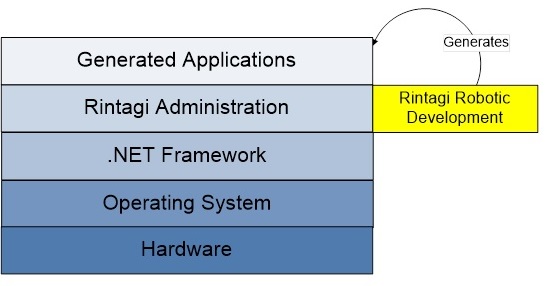
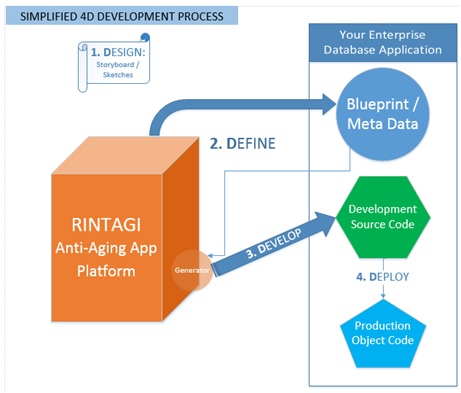
Rintagi does not migrate or transform legacy systems. In order for a Rintagi generated application to replicate the functionality of a legacy system there must be some degree of re-development or re-factoring. The overall legacy system should be well understood and it should exhibit some degree of variability before it can be interpreted into an effective blueprint. Although existing legacy code can be “templatized”, the Rintagi philosophy discourages taking inefficient or “bad” legacy code to create a generator that can recreate the same legacy code because no efficiency will be gained. Consideration should be given as to why the legacy system needs to be migrated in the first place. Typically it means the system needs to be evolved, including its internal structure. Therefore the effort invested in making it “model-driven” is probably well spent, since it helps to achieve the goals of improving the structure of the system. Once converted Rintagi can maintain the system’s fitness and avoid the need for migration in the future.
Agile development methodology, familiar to developers, is the basis for Rintagi. It was designed by certified Scrum master. It generates much of the basic code so that more functionality can be added at a faster rate, embracing late-change-no-penalty. It produces standard service-oriented web applications on a n-tiered architecture, including the user interface pages and the code behind, web-services, SQL queries, stored procedures and transaction management code. Rintagi produces a custom working application, not just a prototype or individual components. The application can be built in just a few hours.Thus, high-productivity to all users. Modifications and enhancements to the user interface are instantly incorporated with each re-generation of the code which occurs dynamically with just-in-time compilation. In other words, you see what you have changed immediately with instant feedback, all the time.
Rintagi builds industry standard applications like these with the standard N-tier architecture preferred by most corporate developers.
Typical Rintagi Responsive Screen Interface
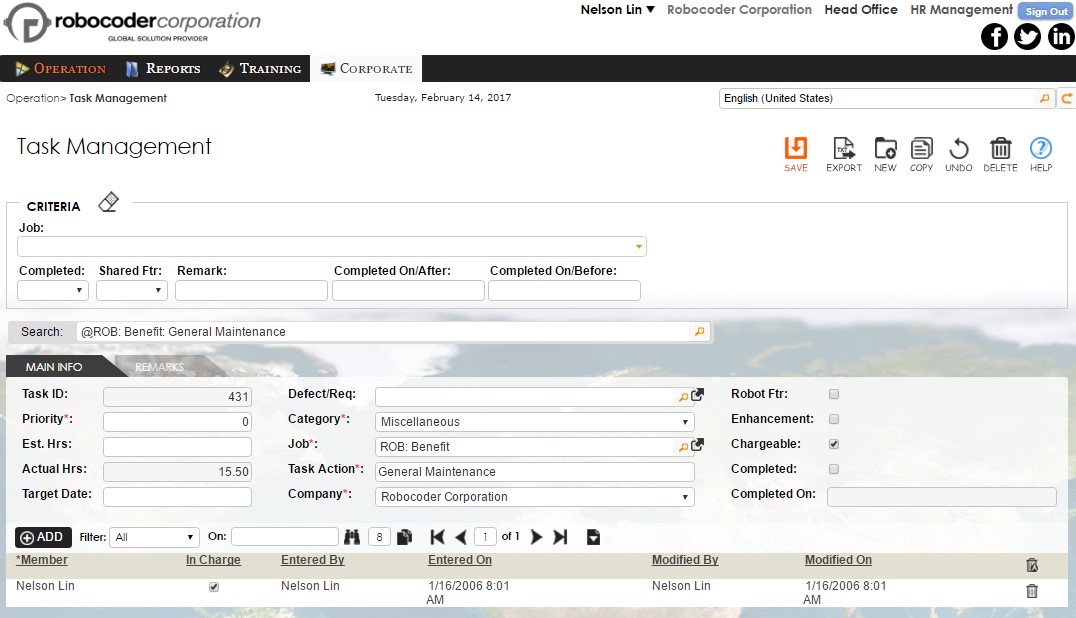
The generated code includes complex features like multi-table joins, multi-table access and distributed update on multi-servers, user interface functionality like search and navigation, and security. Rintagi generates all three tiers of standard code: HTML5, CSS3, JavaScript on the Client Tier, C# on the Web Tier and SQL stored procedures and functions on the Data Tier. Developers enjoy unrestricted access to 100% of the generated code, and modifications to the generated code via metadata changes are automatically preserved when an application is re-generated. You may run your Rintagi generated applications anytime, anywhere without concerning hardware, servers, network, security, etc. Applications generated by Rintagi is automatically multi-tenant. Unlimited number of companies and their data can coexist on the same database.
Rintagi builds complete N-tier applications on a Service-Oriented Architecture.
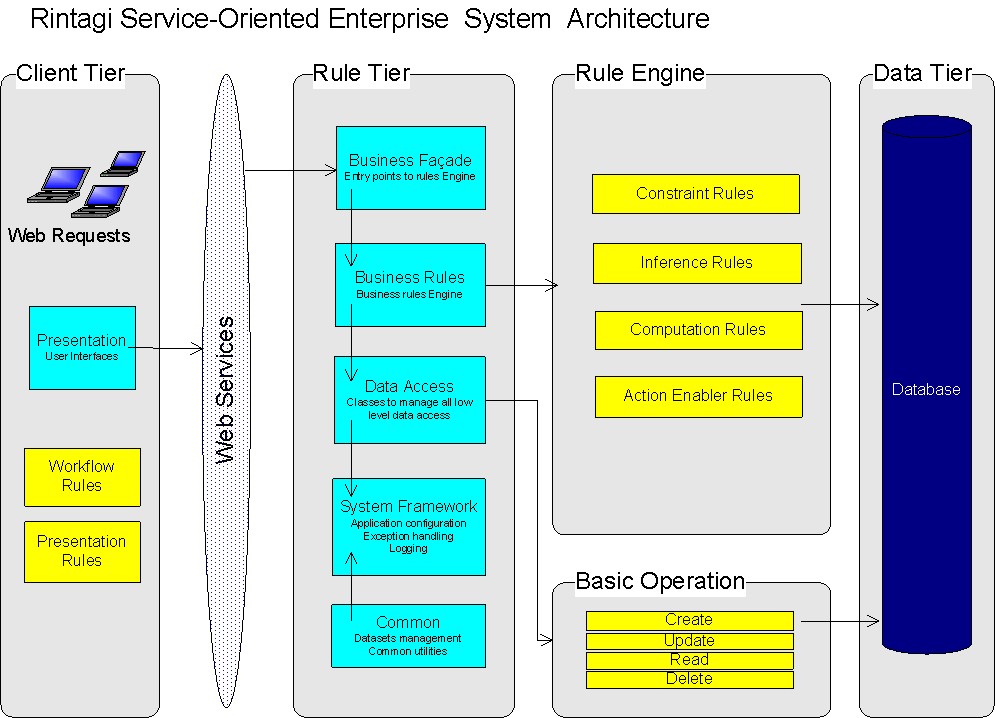
Enterprise-ready web-based service-oriented N-Tier applications
Self-generated Rintagi creates an enterprise-ready, web-based N-Tier application on a service-oriented architecture. Rintagi generates this same N-Tier application for its enterprise applications including Web Pages, Presentation Layer, Business Rules Layer, Data Access Layer, Database Layer, and Framework.
Web Pages: Based on user-specific design, Rintagi generates applications user interface, including the web pages, dialog pages, menus, and search and navigation components. Rintagi generates complex display components including tab folders with data from multiple database tables and from multiple servers.
Presentation Layer: Rintagi generates the code behind each of the web pages and the user controls as modules from those pages. Rintagi can generate a data grid comprised of data joined from multiple database tables and servers. A single update can simultaneously update multiple tables on different servers. Reporting criteria is available to all reports, providing additional reporting flexibility to end-users. Last selected criteria are also cached for individual users. Users may designate each set of criteria with a name for the ease of running reports with the same criteria at a later time or at intervals. Rintagi generates all of the user interface code necessary to support the application’s web-based user interface, including filtering criteria and data validation logic for built-in data types. User-defined constraint rules can be set up to perform custom validation. All web pages and presentation layers run on the client tier can be on a separate server from other tiers.
Business Rules Layer: Adding custom application logic to applications generated by end-users is easy. Rintagi builds applications that are specifically designed to support all types of business rules: 1. Constraints, 2. Computation, 3. Inference and 4. Action Enablers. These rules can be applied
• instantly on the web page as client rules in JavaScript,
• upon post-back as web rules in C#, and
• before or after data manipulation as server rules as stored procedures
and functions.
Applications can be regenerated repeatedly without re-integrating these code extensions. In fact, this is why Rintagi can deliver applications with the highest performance because the data are manipulated where it is currently located, resulting in highest throughput and minimum network traffic.
Data Access Layer: As part of data security, all data manipulation must to go through this layer and can only be called via a business façade layer. Only the business façade layer is exposed as a security feature. The data access codes on this layer encapsulate the characteristics of the databases so that the calling functions can focus on business logic issues. These business façade and data access layers are wrapped inside web-services on a separate server and are available to both Rintagi generated client tiers or other user interfaces from other systems.
Database Layer: SQL stored procedures and queries needed for storing, retrieving, and filtering data are contained in the database. Rintagi will even generate complex queries including multi-table joins with one-to-many and many-to-many relationships. Most of the generated SQL is packaged as a set of database stored procedures in order to provide the best execution and performance with the fewest round trips to the database. Rintagi automatically constructs the SQL queries required for each screen, import wizard and report. Rintagi also generates the database access logic that executes the SQL queries, including all data storage management. Although this database layer can be a separate server like the previous two layers, all three tiers can run on a single server with superb performances because of the optimized codes which become well-tuned over time.
Framework: Rintagi generates web-based applications that run on the Microsoft .NET framework, making applications easier to integrate, deploy, and manage. The industry-standard codes generated can be modified easily using Microsoft Visual Studio. Development time is dramatically reduced leaving the developers to focus on business rules, customization and integration. Reports can be generated to run on Crystal Report, SQL Reporting Services, and/or Power BI Services.
Bridging the Business/Technical Chasm
Using Rintagi, business users may create simple applications using the interfaces provided, much like running any business application. They can then turn to technical staff to complete the applications using Rintagi-provided interfaces to add sophisticated business rules, advanced user interactions, etc.
Rintagi can create most advanced database applications. If you encounter features that Rintagi cannot address, we recommend two options: :
1. Modification of Rintagi and notifying us so that we can incorporate your
modifications into the next version of Rintagi; or
2. Make the changes directly on your generated code and mark the changes so
that they can be reapplied after the next upgrade from Rintagi.
Unlike other enterprise systems, the older Rintagi becomes, the ‘wiser’ it will be and the more functionality can be.
Chapter 2
Creating an Application
Application creation is part of the automated deployment process. The following executable installation process will create a new application for development of production. It can also be used to upgrade existing application or to create a new Rintagi.
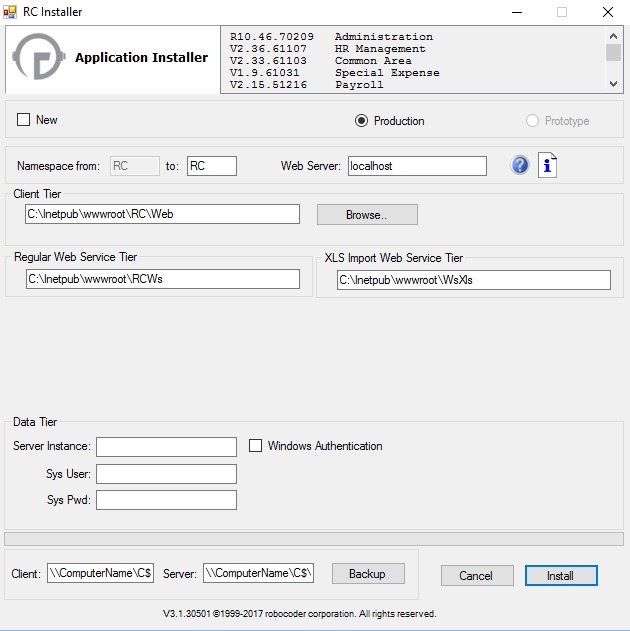
Chapter 3
Customizing an Application
Web pages generated by Rintagi can be modified in many ways: :
1. Screen, report or wizard
2. Menu style and structure
3. User preference
4. Styles
The web pages generated by Rintagi are in CSS3 and HTML5. All pages generated are browsers independent.They have been well tested on many versions of IE, Firefox and Chrome. Using Web Rule, the following can be applied in addition to modifying web page layout by the above: :
1. Add any number of database-bounded components.
2. Change the look and feel or style of the generated components.
3. Create component and page templates that can be applied to other pages.
4. Integrate with other applications.
Adding a New Screen
Log into the application as a developer, then Select “Administration” system from user profile. Then select “Screen Definition” as follows:
Select the desired screen types: :
1. Tab-Folder Only: single record update
2. Tab-Folder with Grid: single record update for tab-folder tables and
multiple records update for grid tables
3. Data-Grid Only: multiple records for grid tables
Screen Definiton
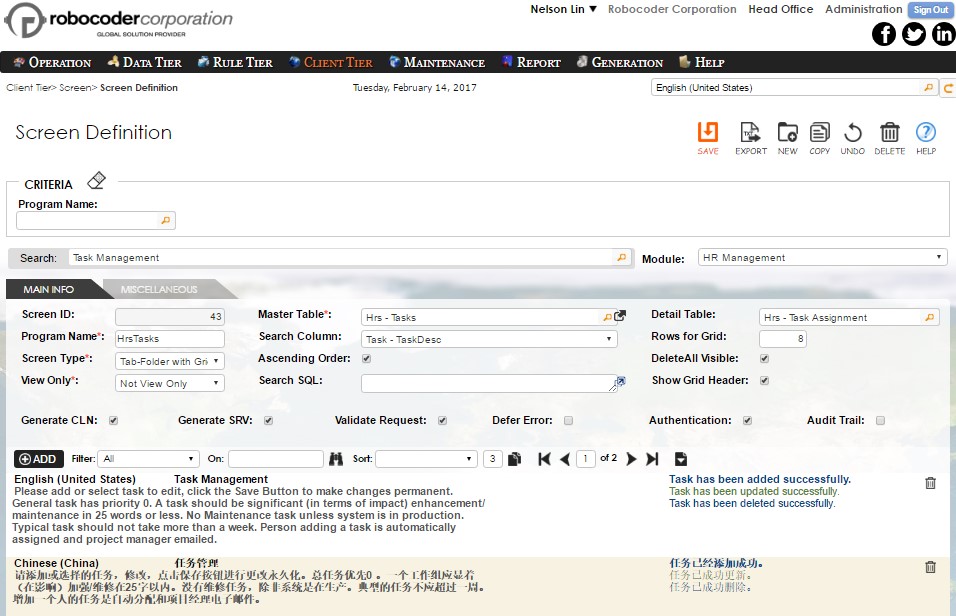
The “Program Name” provided would be used as a prefix to all of the programs generated for this screen. A list of all the programs generated for the above screen can be obtained by Systems -> Program Listing and selecting the appropriate human language.
Program Listing Report
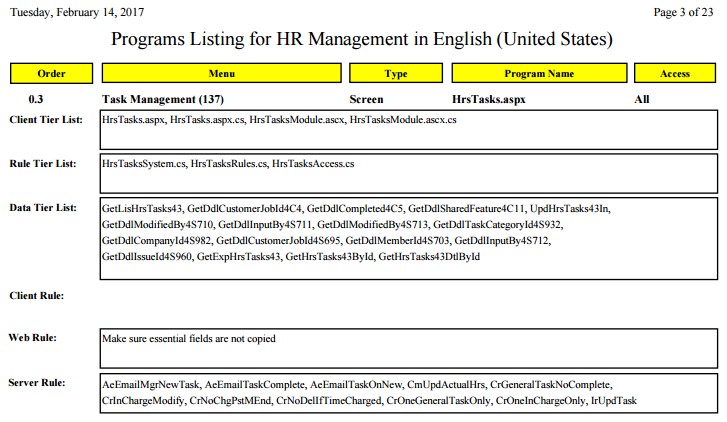
In case you want to know, the programs generated are distributed to three separate tiers identified in Web.config: :
1. Client Tier: key="ClientTierPath"
2. Rule Tier: key="RuleTierPath"
3. Data Tier: key="DataTierPath"
<appSettings>
<add key="ClientTierPath" value="C:\Inetpub\wwwroot\RO\Web\"/>
<add key="RuleTierPath" value="E:\RoboCoder\DotNet\RO\"/>
<add key="DesServer" value="SERVER123"/>
</appSettings>
Customizing Screen:
Screen layout can be modified using Client Tier -> Screen -> Object IDE. The layout of columns can be determined drag and drop onto various tab-folders and grid. OBJ-Property specify the behaviors of these columns. OBJ-Permission enable visibility, editability, and exportability on who can see what down to the cell level. Multilingual labels, watermarks, tooltips and error messages can be specified using OBJ-Label.
Object IDE
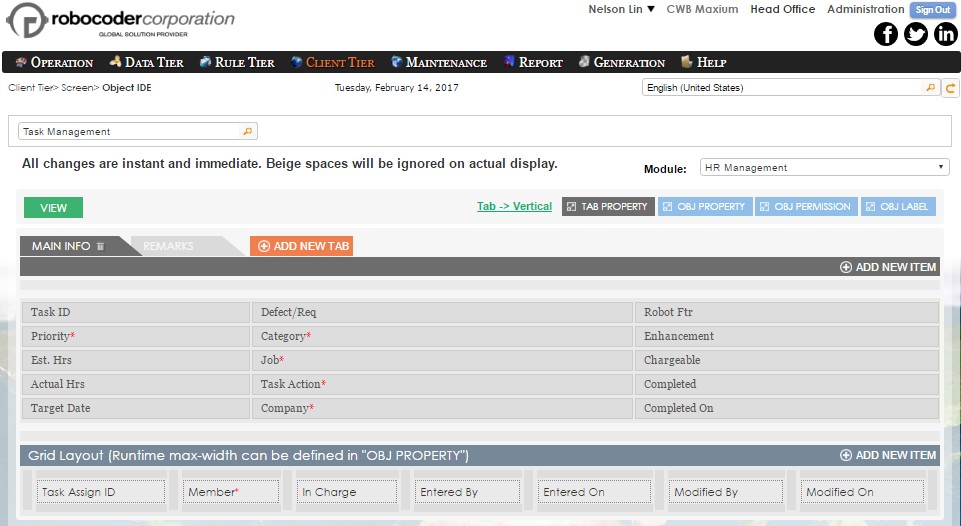
Column properties such as auto-complete vs dropdown, checkbox vs textbox ,the width and height of a multiline edit textbox, etc. can be specified here:
OBJ Property
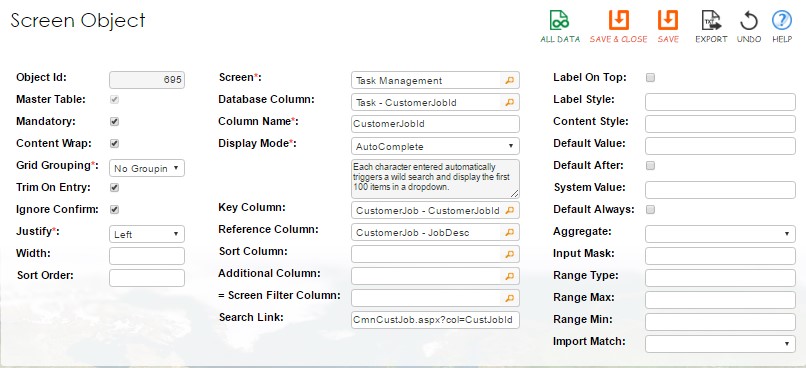
Each column can further be designated as visible/invisible, read-only/editable and exportable/non-exportable for individual user or user groups and others.
OBJ Permission

Moreover, multilingual labels and messages can be determined here:
OBJ Label
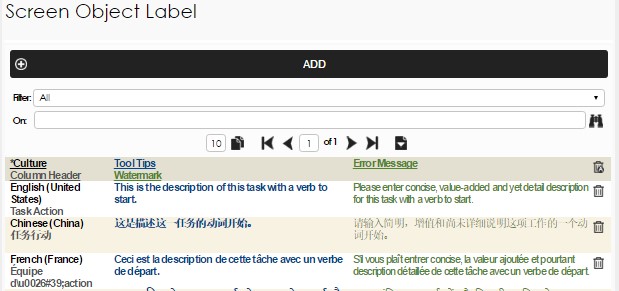
Modifying Style Sheets
Rintagi uses Cascading Style Sheet (CSS) files to specify the styles used for the web pages, panels and controls created for the application, providing a standard look-and-feel to the application. The style sheet files are located in the css directory. _base.css has all the underlying css base classes. _screen.css has the overriding css classes for screen related interfaces. _print.css is for reporting and printing use. All these can be overridden by user preference css described as below, if any.
Modifying User Preference
User Preference can be used to change the functionality or look-and-feel for overall design theme. The colors, fonts, positioning, and other stylistic elements specified by the above style sheet can be overridden by the style sheet text box in this User Preference area. Splash image, menu options, shortcuts settings, quick launch, etc. can also be specified.
Each user-defined preference can be assigned to individual users, user groups or the entire system. Any user may hide the company and/or system selection.
User Preferences Configuration
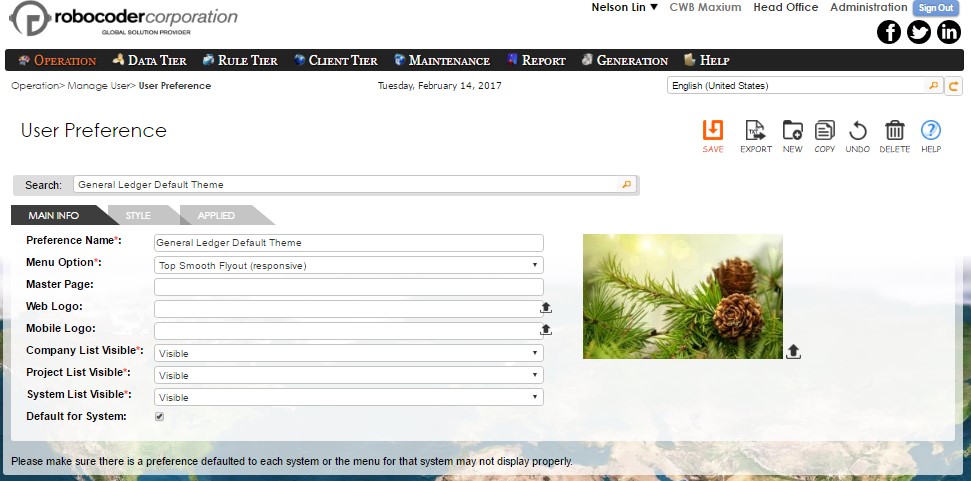
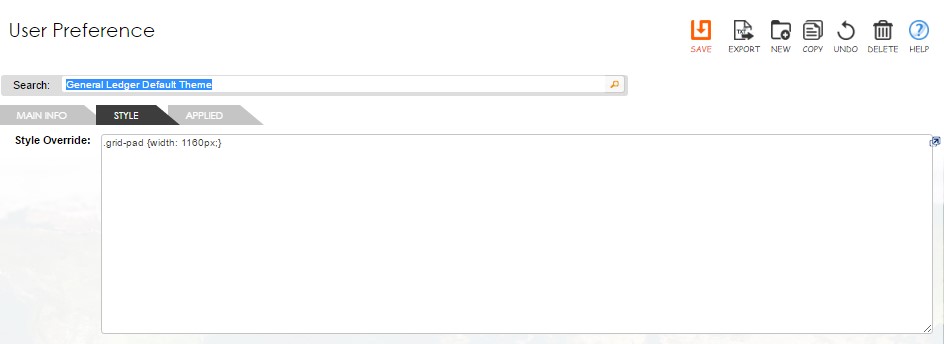
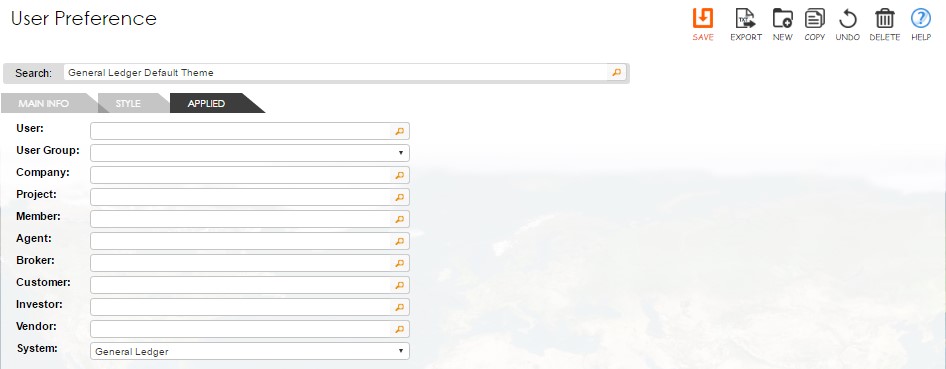
Multilingual Ready
Rintagi generated enterprise applications are multilingual. Once the application is built in English then labels, watermarks, tooltips, error messages, etc. in many other human languages can be automatically generated by Rintagi. Human translators may inspect and change to preferred phrases and wordings without involving technical staff. For those languages not provided automatically, translation into any Unicode supported language can be accomplished via Rintagi’s user-friendly interface.
Each human language can be translated within minutes by the press of a button. It utilizes the Google automatic translation engine. The cost is minimal. Although not all translations are done perfectly, it is improving all the time and correcting them using Rintagi interface cannot be faster and easier than translating from scratch.
Translation Screen
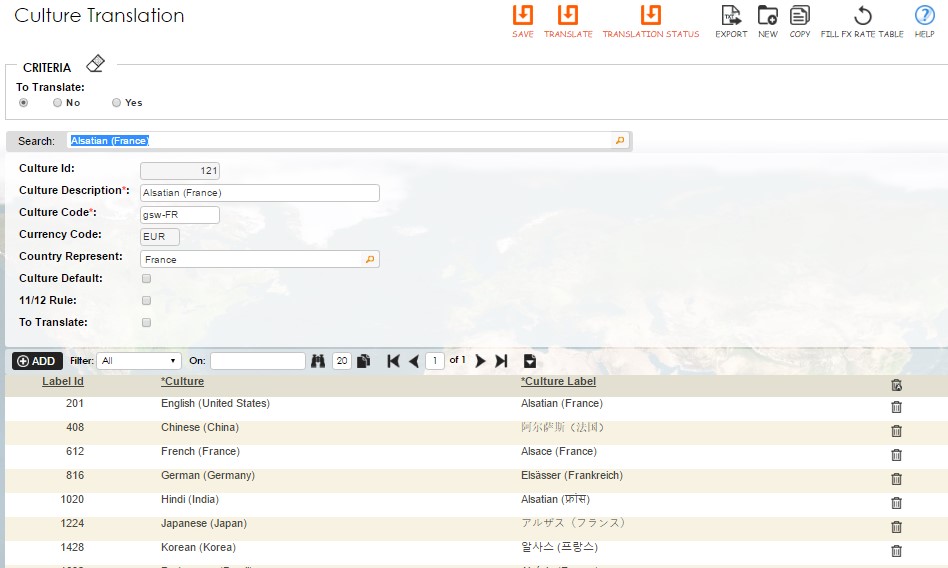
User Management
Each user is designated one or more user-defined user groups and a specific human language with a country-specific locale. Although each user may belong to many user groups, only one human language can be designated at a time.
User Manager
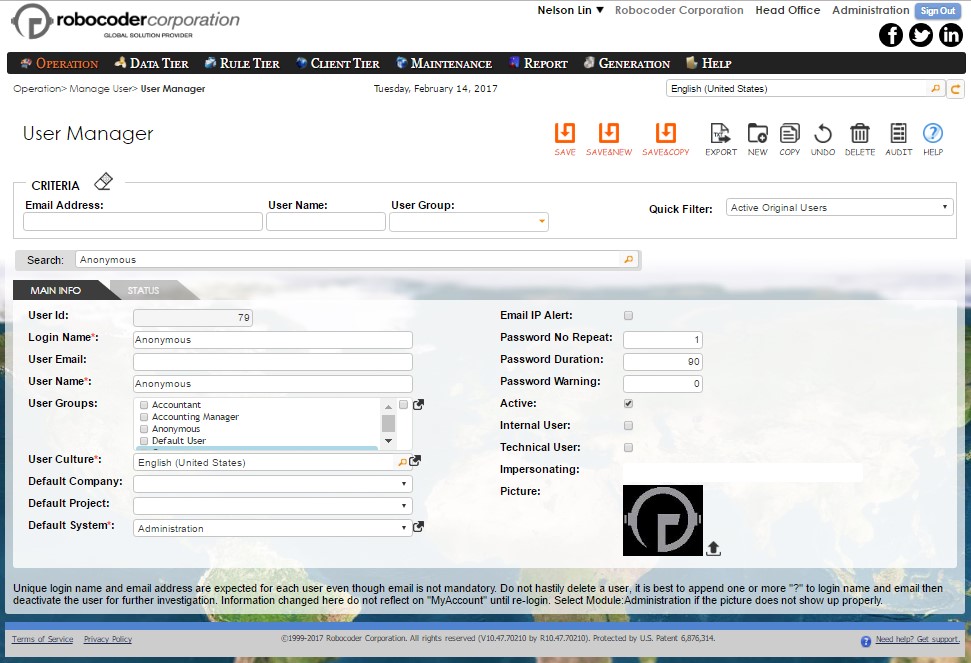
Integrating Other Applications
Applications generated by Rintagi can be easily integrated with other systems via web services and API interfaces.Rintagi-generated applications can operate as separate, independent applications because of the stateless nature of web programming. One application may call into another via the URL mechanism inherent in all web applications.
For example, Rintagi-generated applications can call any web page from within its menu.
Menu URL integration
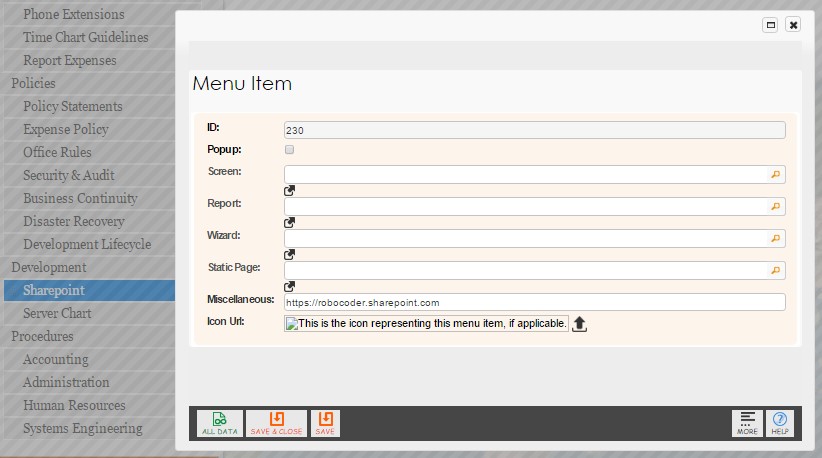
Other applications can call any Rintagi-generated programs via a standard html anchor. For example: <a href=”http://www.abc.com/testing.aspx”>testing</a>.
Integration can also be done via web rule, as well, where other web pages and web services of other applications can be called and the results integrated into Rintagi-generated applications.
Web Rule
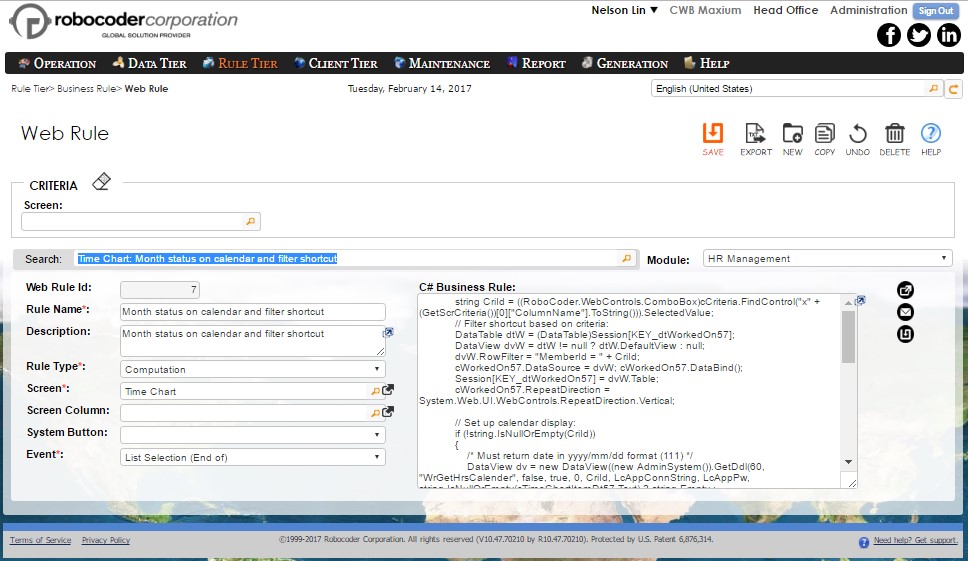
Server-side integration can be done via the database level with stored procedures, etc.
Adding a Report or Business Intelligence
Although Rintagi has an Easy Report Generator that enables business users to create simple list, tabular reports, charts, and dashboard gauges in minutes, we recommend using standard report designers provided by Crystal Reporting, SQL Reporting Services and Power BI Services.
Chapter 4
Configuring Navigation Controls
Rintagi has a convenient built-in screen for configuring navigation menu panels via drag-and-drop we called Menu IDE.
Menu IDE
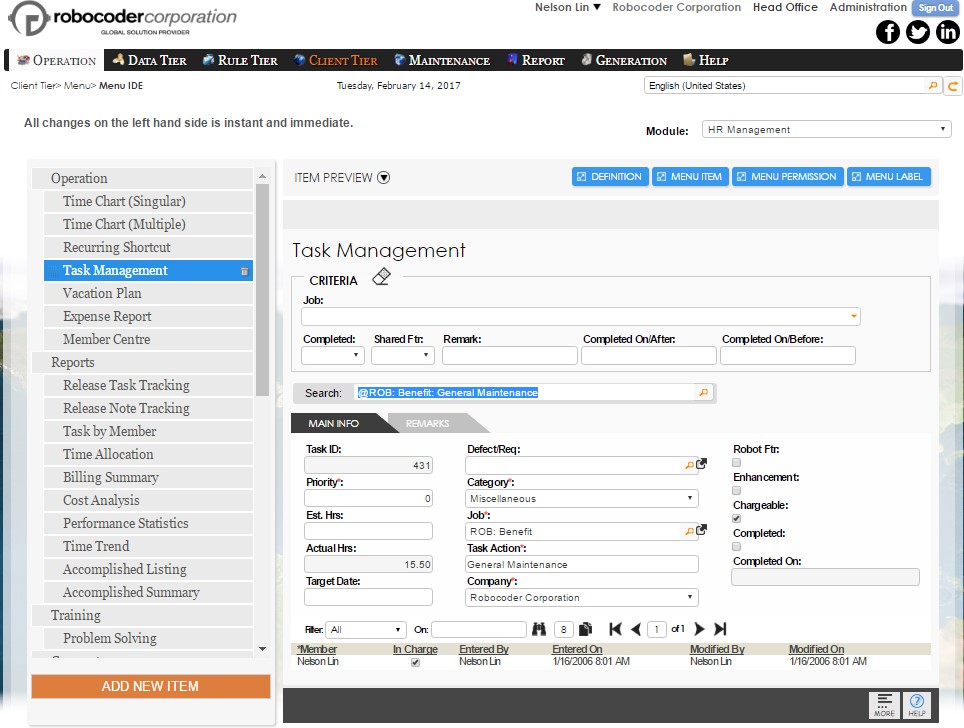
Screen buttons can also be configured via a built-in screen. Not only display names and tool tips can be overridden by culture-specific and user-specified phrases but also they can be replaced with favorite or branded images.
Button Modification Screen
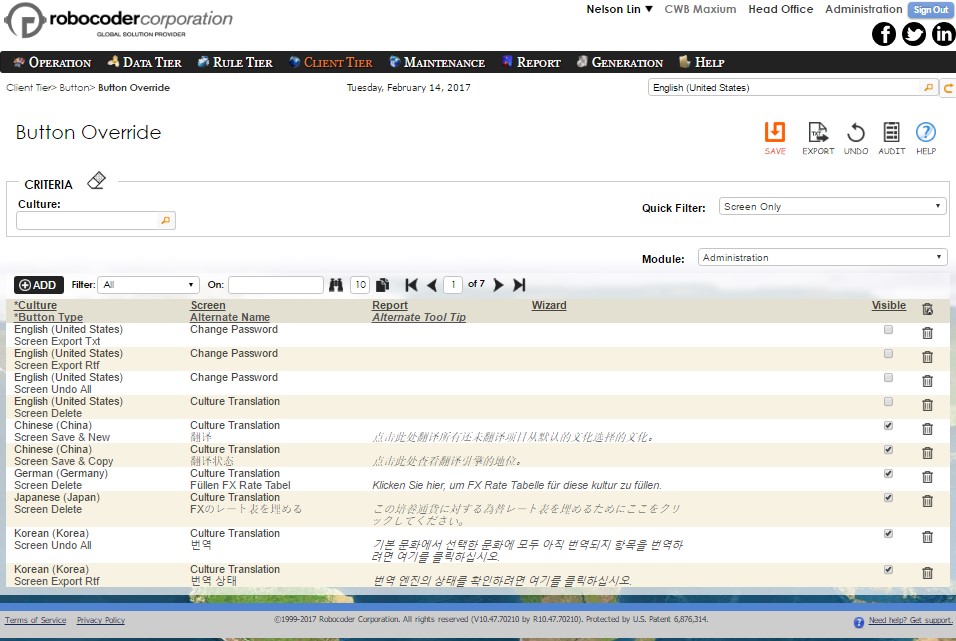
Chapter 5
Building and Running Application
Application generation in Rintagi is easy. All screen, report, and wizard programs are regenerated within a second upon most changes automatically and implicitly when the screen is relaunched. All changes are dynamic seamless to the developers.When necessary, using the interface below, they can also be generated explicitly one by one or all at once, or in batches, allowing iterative modification of the application and quick regeneration to see changes.
Screen Generation
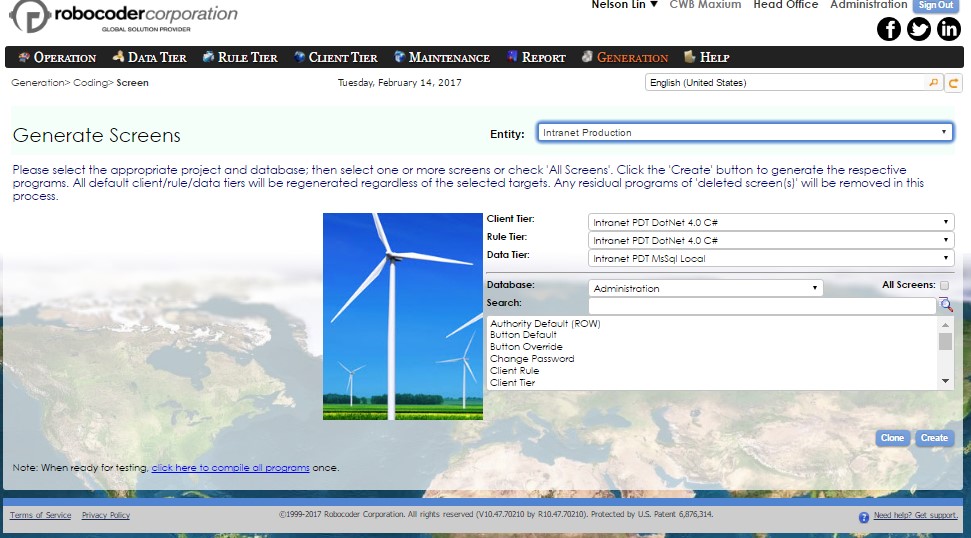
During the application generation process, a variety of programs are generated for the application, including: :
1. Web pages consisting of HTML5, CSS3, JavaScript, and their C# code-behind
classes.
2. Web rules embedded in the C# code behind. Client rules in JavaScript
are dynamic.
3. A set of database stored procedures and functions composed of standard SQL.
The principle of ACID (Atomicity, Consistency, Isolation, Durability) rule
is adhered. Transactions only commit if all business rules have been passed
without error.
4. Server rules as explicit stored procedures.
Although compilation is automatic and seamless to Rintagi users, you may use Visual Studio to compile and perform low level diagnostic.
Rintagi generated applications can be tested on the development platform or be published to a test server for user acceptance testing. Deployment to production server is also just a press of a button.
On-premises deployment, if so desired, is also as simple as generating one installer, and running it on the designated servers. The installer is one simple .exe file embedding all of the changes required for application to the target servers and databases. Clicking on a URL will run Rintagi-generated applications like any other web-based application. Each application developed will have its own separate URL to be distributed to those end-users who need access.
Prepare Installer Package
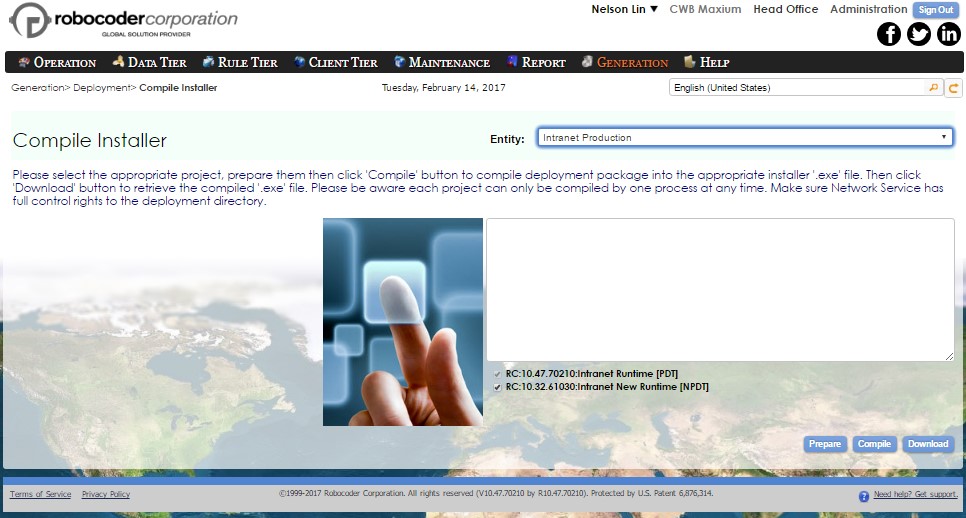
Chapter 6
Document Control Audit
Rintagi automatically provides and updates four kinds of documentations that are usually difficult to keep up-to-date when applications are being enhanced frequently. They are: Data Dictionary, List of Business Rules, List of Programs, and List of Error Messages.
Data Dictionary
Each application generated by Rintagi keeps its own data model as meta-data or a blueprint. If a description has not been entered for each data column, the tooltips are automatically copied to describe the data columns as they are entered as part of the intelligence. As the application grows and changes, each additional data table or column is tracked and updated to the data dictionary. These data models must be kept up-to-date because the application is generated based on it. Therefore, the documentation on these is automatic and most accurate.
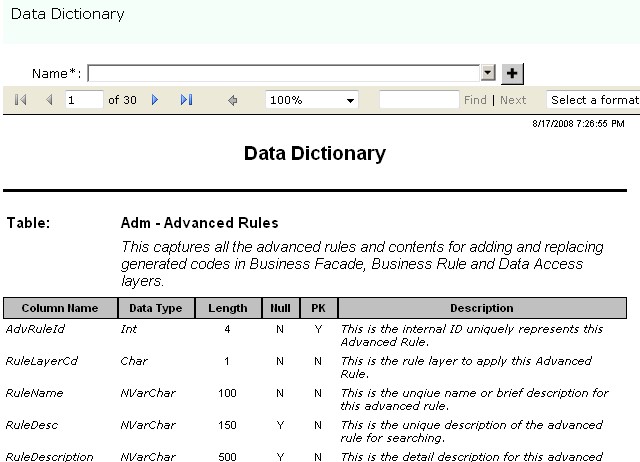
Business Rule Listing
Business rules will be covered in later volumes of advanced topics. For sophisticated developers to have high control, many different kinds and different types of business rules may apply to Rintagi-generated applications. In the traditional programming world, these business rules are usually embedded or hidden in the programs and are very difficult to extract. Thanks to the metadata structure employed by Rintagi, not only can business rules be extracted easily for modification, they can be listed anytime for reference and communication as follow.
List of Business Rules
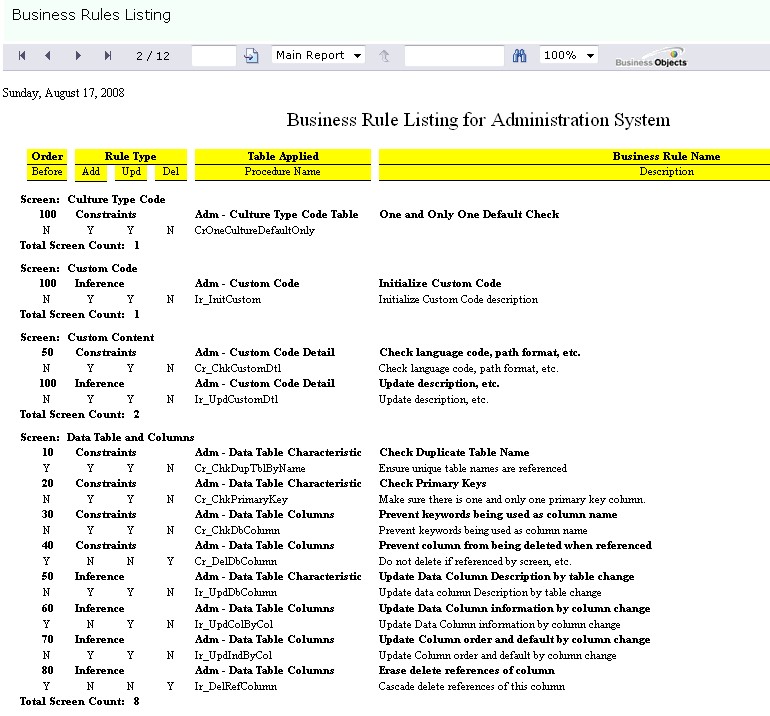
Program Listing
In the past the tracking of computer programs was an arduous process. Not so with Rintagi as programs are being generated and maintained constantly by itself. Custom programs can be added but they will not be listed here.
List of Programs
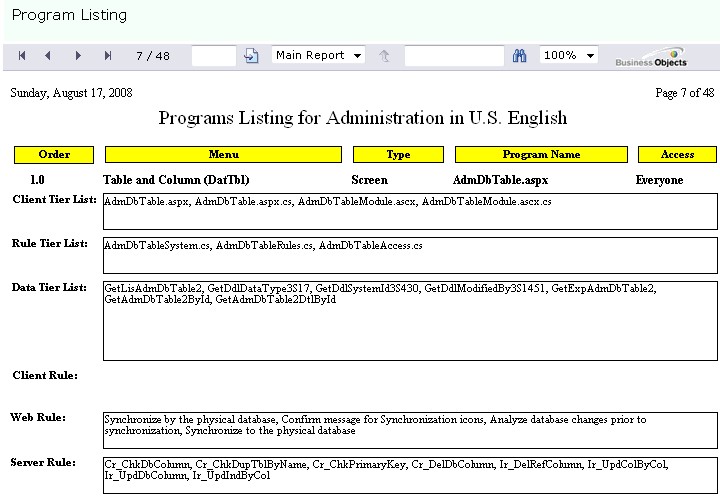
Message Listing
By selecting a desired human language, an up-to-date listing of all of the screen online help messages, labels, tooltips and error messages are immediately available.
List of Messages
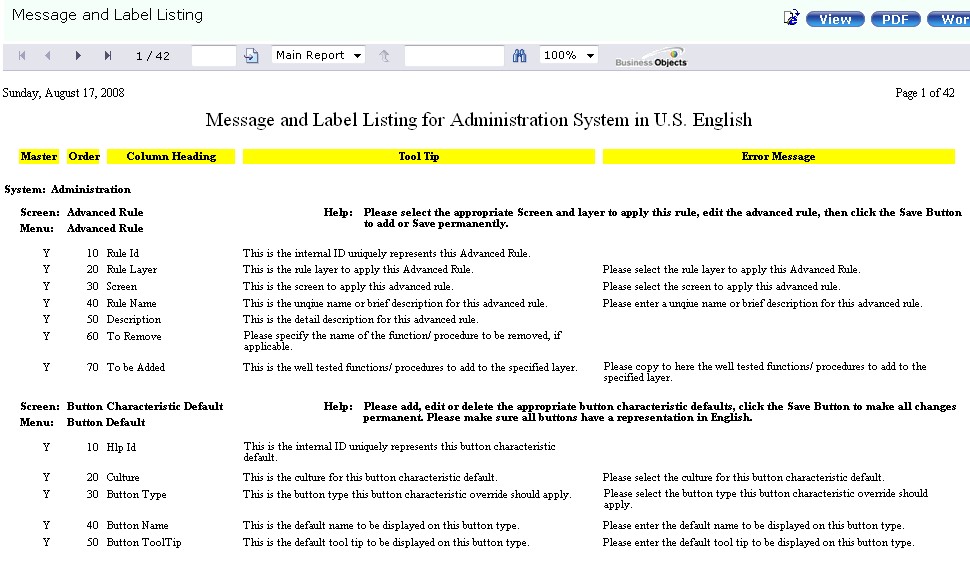
Chapter 7
Usage and Version Tracking
Because of the robust design of Rintagi, daily and weekly releases are common. Rintagi automatically tracks the usage and the contents of each release: :
1. Usage Report
2. Release Tracking
Usage Report
A comprehensive list of criteria is available to the administrator for tracking the usage of the applications. This includes Rintagi itself, as it is self-generated.
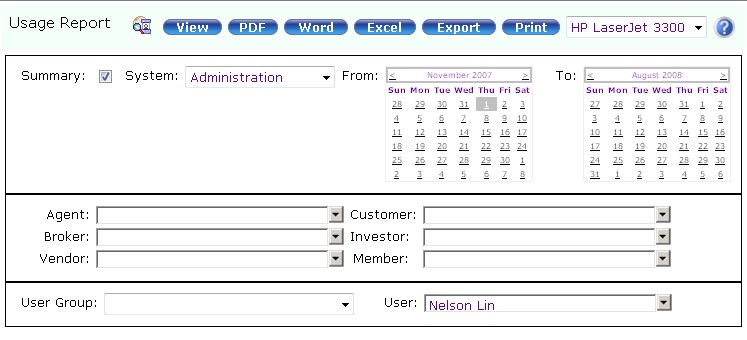
Release Tracking
Rintagi automatically creates the necessary change script to be executed on the next release each time the data model is modified. No hand-coding is necessary although you may add more to them for your own convenience.
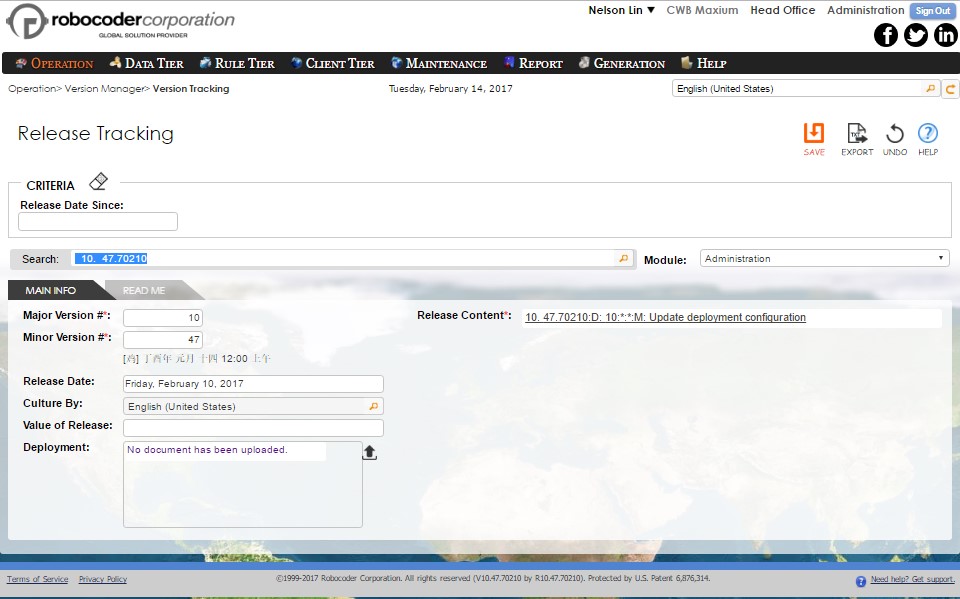

A report is also available as readme for tracking manually prepared release notes:
Release Readme Notes
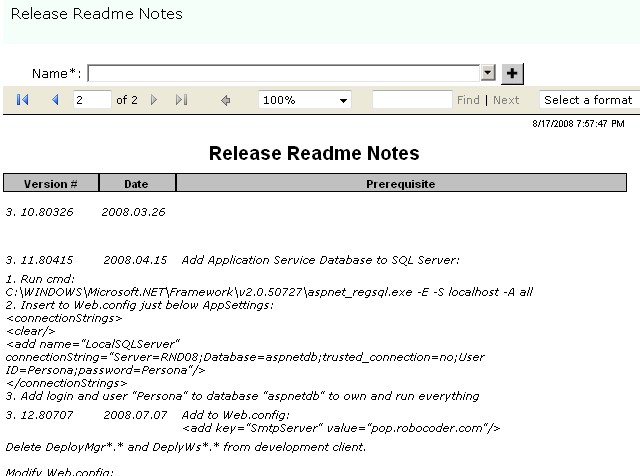
Chapter 8
Security & Policy
In the old days when enterprise applications are on-premises, physical access was on the top of the list of major concerns when it comes to computer security. Then Virtual Private Network becomes a security concern, when the private network is extended across a public network, such as the Internet. Today many of our clients are running their enterprise applications from the cloud. Literally anyone knowing the URL can access their applications from any browsers on any computer in the world. As part of the access control, Rintagi addresses that by IP Allow List, customized password complexity requirements, CAPTCHA, two-factor authentications, etc.
Once authenticated, authority is assigned based on role, organization, responsibility and business rules. These security controls have enable generated applications that are not only multi-tenant, but also connecting customers and vendors to share valuable data online and real time for effective and efficient communications.
In addition, with the exception of authorized developers, all data entry screens are protected from script injection attack.
Access Policy
The access policy includes the following aspects of access management: :
•User authentication controlled solely by user account and password combination;
•User may have multiple login sessions simultaneously;
•Multiple user accounts can share the same email address;
Password Policy
The password policy includes the following aspects of password management: :
•All passwords are stored via secured salted one-way hash;
•Users are prohibited from login after five (5) consecutive unsuccessful login
attempts, regardless if the login name is found;
•User may change password at any time; Administrator may set it up to be changed
every n days via password expiration, default is 180 days;
•Administrator may inactive a user login at any time;
•User cannot reuse existing password as default; Administrator may set it up so
that User cannot reuse an existing password used in the past;
•Force new user to change password upon first login;
•Enforce custom password complexity policy (eg. minimum length, mix of case and
alphanumeric, etc.);Typical minimum length (8 characters at least one alpha, one
numeric and a capital letter); this can be configured easily in Web.config;
•Email user on unsafe IP address upon login; user may respond positively to keep
this IP on the safe list or change password right away.
Login Audit
Successful and unsuccessful logins are tracked and can be reported as follow.

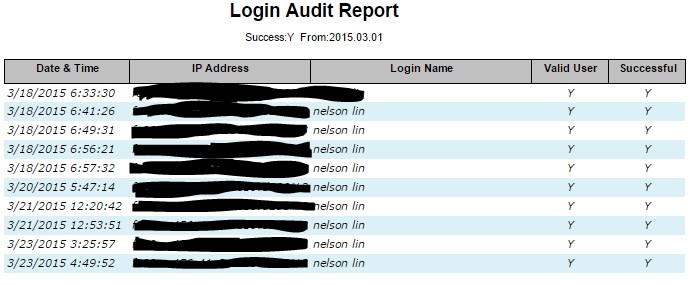
Permission Listing
By selecting a desired human language, an up-to-date listing of all authorization permitted to access or denied from access are displayed. It covers four sections: Menu, Report, Screen, and Import Wizard. Checking Active-User-Only will exclude user groups or other entities that have no users assigned to them. Details of authorizations and permission management can be found in the User Guide Volume 6 – Rights Management.

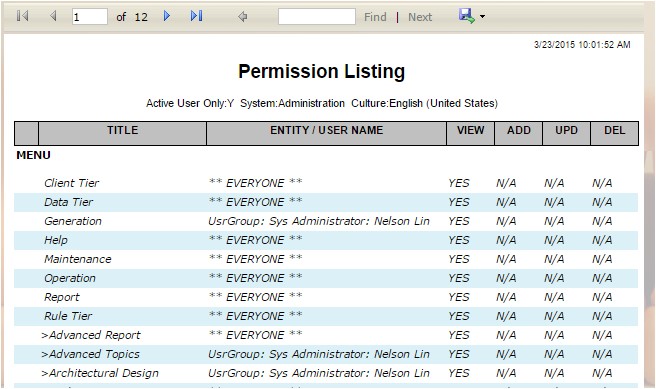
User Listing
This is a list of all the users, their general authorization levels and who they may be impersonating. Details of authorizations and permission management can be found in the User Guide Volume 6 – Rights Management.
